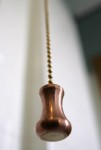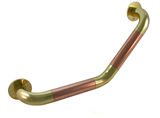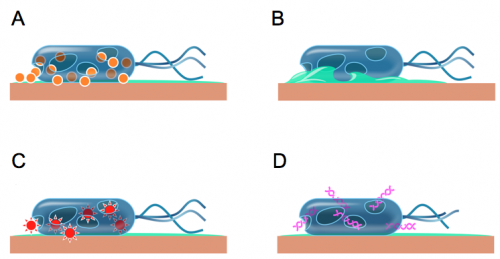Al eerder schreef ik over de anti-microbiële werking van koper (zie link). Het toepassen van koper bij contactoppervlakken in ziekenhuizen kan de verspreiding van infecties tegengaan. Ook de zogeheten ‘ziekenhuisbacteriën’ zoals MRSA, die resistent zijn tegen antibiotica, worden door koper gedood.
Het onderwerp is nu zeer actueel door Corona en eerder ook door het oprukkende Ebola-virus. Kan koper ook virussen doden, speciaal het SARS-CoV2 en het Ebola-virus?
Wilton Moran probeerde de vraag of koper virussen doodt te beantwoorden voor Ebola. Hij schrijft over The antiviral efficacy of copper surfaces versus Ebola en vindt dat er voldoende basis is om te concluderen dat koper ook het ebola-virus doodt (de structuur van het ebola-virus lijkt namelijk op dat van het influenza-virus). Dit kan echter niet getest worden, omdat ebola zo gevaarlijk is dat er geen enkel laboratorium veilig genoeg is om onderzoek naar het virus te mogen doen.
Een citaat van www.antimicrobialcopper.com:
“Is copper effective against Ebola?
“While the efficacy of copper against Ebola has not been tested, antimicrobial copper has been shown to inactivate the two major types of viruses: those with a viral envelope covering their protective protein capsid and those without a viral envelope. Specifically, antimicrobial copper has been shown to inactivate both Influenza A (an enveloped virus) and norovirus (a non-enveloped virus).
“Ebola virus, like Influenza A, has an envelope protecting its viral genome. Both are also negative sense single-stranded RNA viruses. Ebola has glycoprotein spikes and a nucleoprotein protecting the RNA, and Influenza A has similar features. Thus, since copper inactivates Influenza A, because of their similar characteristics, there is a basis to assume that copper may also inactivate Ebola. However, because Ebola is highly contagious, any tests would have to be conducted in a high Biosafety Level 4 containment laboratory.
“In conclusion: the deployment of antimicrobial copper touch surfaces in healthcare and public settings may have the potential to protect against transmission of Ebola.”
Kortom, de kans is groot dat het werkt. En baat het niet, dan schaadt het ook niet.
Hoe werkt het doden van microben door koper eigenlijk? Voor bacteriën heb ik gevonden hoe het mechanisme werkt, in een artikel van Marc Solioz: Copper kills bacteria: end of hospital-acquired infections?
Eerst een stukje geschiedenis uit zijn artikel:
“The use of copper in medicine is not new. Medical applications of copper were already described in the Egyptian Smith Papyrus, written between 2600 and 2200 BC. […] Greeks, Romans, Aztecs, and others also used copper or copper compounds for the treatment of ailments burns, intestinal worms, ear infections, and for hygiene in general. In the 19th century, new awareness of copper’s medical effects was raised by the observation that copper workers did not contract cholera in the 1832 and subsequent cholera outbreaks in Paris. The use of copper in medicine became widespread in the 19th and early 20th century […].
“The medical use of copper continued until the advent of commercially available antibiotics in 1932. The spread of antibiotic resistance through selective pressure began and today has made antibiotic resistant bacteria like MRSA ubiquitous and a major cause of nosocomial infections. This has raised the need for new approaches to keep pathogenic microorganisms at bay.”
NB toen dit geschreven werd in 2011, waren COVID-19 en Ebola nog niet in beeld. Anders was dat waarschijnlijk ook wel genoemd.
Hoe worden bacteriën gedood door koper?
“What is the mechanism of contact-killing of bacteria by copper? As a first step, the contact of bacteria with the copper surface ruptures the membrane by an unknown mechanism (see figure). This leads to the loss of cell content. Large amounts of copper ions dissolved from the metal surface are then taken up by the cell. The dissolved copper ions react with oxygen, thereby forming so called reactive oxygen species. These are radicals like OH۬·, which can react with biomolecules of a cell and cause severe damage. Finally, the DNA is fragmented into small pieces which seep out of the cell. This sequence of events is still tentative, but it is already clear that the killing of bacteria by copper involves several mechanisms.”
Bijschrift bij figuur: “Schematic representation of the events in contact-killing. Copper ions dissolved from the copper surface causes cell damage (A), the cell membrane ruptures, leading to loss of the cell content (B), copper ions lead to the generation of toxic radicals which cause further damage (C), and DNA becomes degraded and leaves the cell (D).” (bron)
Aangezien de bacterie tot op het DNA uiteenvalt, bevat het ‘restmateriaal’ dat achterblijft geen ziekteverwekkend materiaal meer. Voordeel daarvan is dat het uiteengevallen organisme ook niet meer kan combineren met andere organismen tot een nieuwe ziekteverwekker.
Al eerder schreef ik over de anti-microbiële werking van koper (zie link). Het toepassen van koper bij contactoppervlakken in ziekenhuizen kan de verspreiding van infecties tegengaan. Ook de zogeheten ‘ziekenhuisbacteriën’ zoals MRSA, die resistent zijn tegen antibiotica, worden door koper gedood.
Het onderwerp is nu zeer actueel door Corona en eerder ook door het oprukkende Ebola-virus. Kan koper ook virussen doden, speciaal het SARS-CoV2 en het Ebola-virus?
Wilton Moran probeerde de vraag of koper virussen doodt te beantwoorden voor Ebola. Hij schrijft over The antiviral efficacy of copper surfaces versus Ebola en vindt dat er voldoende basis is om te concluderen dat koper ook het ebola-virus doodt (de structuur van het ebola-virus lijkt namelijk op dat van het influenza-virus). Dit kan echter niet getest worden, omdat ebola zo gevaarlijk is dat er geen enkel laboratorium veilig genoeg is om onderzoek naar het virus te mogen doen.
Een citaat van www.antimicrobialcopper.com:
“Is copper effective against Ebola?
“While the efficacy of copper against Ebola has not been tested, antimicrobial copper has been shown to inactivate the two major types of viruses: those with a viral envelope covering their protective protein capsid and those without a viral envelope. Specifically, antimicrobial copper has been shown to inactivate both Influenza A (an enveloped virus) and norovirus (a non-enveloped virus).
“Ebola virus, like Influenza A, has an envelope protecting its viral genome. Both are also negative sense single-stranded RNA viruses. Ebola has glycoprotein spikes and a nucleoprotein protecting the RNA, and Influenza A has similar features. Thus, since copper inactivates Influenza A, because of their similar characteristics, there is a basis to assume that copper may also inactivate Ebola. However, because Ebola is highly contagious, any tests would have to be conducted in a high Biosafety Level 4 containment laboratory.
“In conclusion: the deployment of antimicrobial copper touch surfaces in healthcare and public settings may have the potential to protect against transmission of Ebola.”
Kortom, de kans is groot dat het werkt. En baat het niet, dan schaadt het ook niet.
Hoe werkt het doden van microben door koper eigenlijk? Voor bacteriën heb ik gevonden hoe het mechanisme werkt, in een artikel van Marc Solioz: Copper kills bacteria: end of hospital-acquired infections?
Eerst een stukje geschiedenis uit zijn artikel:
“The use of copper in medicine is not new. Medical applications of copper were already described in the Egyptian Smith Papyrus, written between 2600 and 2200 BC. […] Greeks, Romans, Aztecs, and others also used copper or copper compounds for the treatment of ailments burns, intestinal worms, ear infections, and for hygiene in general. In the 19th century, new awareness of copper’s medical effects was raised by the observation that copper workers did not contract cholera in the 1832 and subsequent cholera outbreaks in Paris. The use of copper in medicine became widespread in the 19th and early 20th century […].
“The medical use of copper continued until the advent of commercially available antibiotics in 1932. The spread of antibiotic resistance through selective pressure began and today has made antibiotic resistant bacteria like MRSA ubiquitous and a major cause of nosocomial infections. This has raised the need for new approaches to keep pathogenic microorganisms at bay.”
NB toen dit geschreven werd in 2011, waren COVID-19 en Ebola nog niet in beeld. Anders was dat waarschijnlijk ook wel genoemd.
Hoe worden bacteriën gedood door koper?
“What is the mechanism of contact-killing of bacteria by copper? As a first step, the contact of bacteria with the copper surface ruptures the membrane by an unknown mechanism (see figure). This leads to the loss of cell content. Large amounts of copper ions dissolved from the metal surface are then taken up by the cell. The dissolved copper ions react with oxygen, thereby forming so called reactive oxygen species. These are radicals like OH۬·, which can react with biomolecules of a cell and cause severe damage. Finally, the DNA is fragmented into small pieces which seep out of the cell. This sequence of events is still tentative, but it is already clear that the killing of bacteria by copper involves several mechanisms.”
Bijschrift bij figuur: “Schematic representation of the events in contact-killing. Copper ions dissolved from the copper surface causes cell damage (A), the cell membrane ruptures, leading to loss of the cell content (B), copper ions lead to the generation of toxic radicals which cause further damage (C), and DNA becomes degraded and leaves the cell (D).” (bron)
Aangezien de bacterie tot op het DNA uiteenvalt, bevat het ‘restmateriaal’ dat achterblijft geen ziekteverwekkend materiaal meer. Voordeel daarvan is dat het uiteengevallen organisme ook niet meer kan combineren met andere organismen tot een nieuwe ziekteverwekker.
COVID-19 en Ebola worden weliswaar verspreid door een virus, niet door een bacterie, maar het verdelgingsmechanisme van koper zal vergelijkbaar werken. Ook virussen en schimmels worden namelijk snel en effectief gedood door koper.
Voor meer referenties naar wetenschappelijke literatuur over de anti-microbiële werking van koper, zie het artikel dat ik eerder schreef: Voorkom bacteriële besmetting, gebruik koper.
S.L. Warnes promoveerde op het microbiële verdelgingsmechanisme van koper, dat bij diverse micro-organismen op verschillende manieren schijnt te werken. Zie haar proefschrift Laboratory studies to investigate the efficacy and mechanism of action of copper alloys to kill a range of bacterial pathogens and inactivate norovirus, door S.L. Warnes Zij promoveerde in 2014 op dit proefschrift aan de University of Southampton.
Via deze link is het proefschrift te downloaden.
COVID-19 en Ebola worden weliswaar verspreid door een virus, niet door een bacterie, maar het verdelgingsmechanisme van koper zal vergelijkbaar werken. Ook virussen en schimmels worden namelijk snel en effectief gedood door koper.
Voor meer referenties naar wetenschappelijke literatuur over de anti-microbiële werking van koper, zie het artikel dat ik eerder schreef: Voorkom bacteriële besmetting, gebruik koper.




